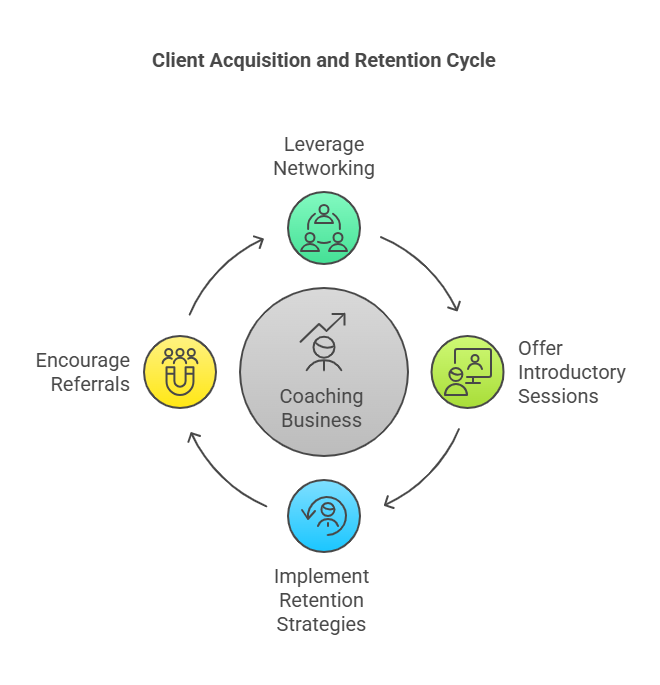You love helping people reach their full potential but starting your own life coaching business might feel overwhelming. You probably have questions: Where do I even begin? How do I find my first clients? Can I actually turn my passion into a successful, profitable business?
Here’s the good news: Starting your life coaching business doesn’t have to be complicated. This guide will walk you through each essential step from defining your niche and attracting the right clients to building a strong brand, marketing effectively, and creating long-term success. By the end, you’ll have a clear roadmap to confidently launch your coaching business, start earning income, and make a meaningful impact.
How to Set Up a Life Coaching Business: Define Your Niche
Finding your niche isn’t just about picking a category it’s about standing out in a crowded field. The clearer your focus, the easier it is to attract the right clients. People don’t just want a life coach; they want their life coach someone who understands their specific challenges and goals.
Choosing Your Coaching Specialization
Think about what problems you’re best at solving. Are you great at helping people advance in their careers? Do you have a deep understanding of health and wellness? Maybe you’re passionate about helping people navigate relationships. Your niche should align with your skills, personal experiences, and what excites you most.
A broad approach can leave potential clients unsure if you’re the right fit. Instead of just being a life coach, you could be a career transition coach for mid-level professionals or a mindset coach for entrepreneurs. The more specific, the better.
Understanding Your Audience
Who needs your coaching? What struggles keep them up at night? If you can describe their problems better than they can, they’ll trust you have the solutions.
Start by outlining your ideal client. What’s their age, background, and lifestyle? What goals are they trying to reach? Are they professionals looking to climb the corporate ladder, parents trying to find balance, or young adults searching for direction? When you understand their challenges, you can speak directly to them in your marketing.
Building Credibility Through Certifications
You don’t need a certification to be a life coach, but having one can help establish trust. Programs from organizations like the International Coaching Federation (ICF) signal that you’ve put in the work to refine your skills.
That said, experience often outweighs credentials. If you’ve successfully helped people in the past whether formally or informally those results matter more than any certificate. Client success stories and testimonials will always be your most powerful proof of credibility.
Research and Plan Your Business
A great coach without a plan is like a ship without a compass drifting aimlessly. Before you start coaching, you need to know your market, define your goals, and create a clear path forward.

Conducting Competitor Analysis
Look at other coaches in your niche. What are they doing well? Where are they falling short? This isn’t about copying it’s about finding gaps you can fill.
Browse their websites, social media, and client reviews. If they all focus on “finding purpose,” maybe there’s an opportunity for you to specialize in building confidence or overcoming self-doubt. If they charge by the session, consider offering structured programs with clear milestones.
Creating a Business Plan
Your business plan doesn’t need to be complicated, but it does need to exist. Outline your services, pricing, marketing strategy, and revenue goals.
- Services – Will you offer one-on-one coaching, group sessions, workshops, or online courses?
- Pricing – Research what other coaches charge, but don’t undervalue yourself. If you bring real results, people will pay.
- Marketing – How will you attract clients? Social media, speaking engagements, partnerships, or content marketing?
- Revenue Goals – How many clients do you need each month to reach your income target?
A plan keeps you focused. Without one, it’s easy to waste time on things that don’t move your business forward.
Setting Business Goals
Vague goals like “I want to help people” won’t keep you on track. Instead, be specific:
- “I will book my first three paying clients within 60 days.”
- “I will launch a website with a free lead magnet by next month.”
- “I will reach $5,000/month in revenue within six months.”
Clear goals create momentum. Every time you hit a milestone, you’ll build confidence and motivation to push forward.
Now that your foundation is set, it’s time to get your business legally and financially ready.
Handle Legal and Financial Setup
Before you start coaching, you need to handle the business side of things. Setting up your business properly protects you from legal trouble, keeps your finances in order, and makes you look professional. It’s not the most exciting part, but skipping it can lead to headaches later. So let’s break it down step by step.

Choosing a Business Structure
Your coaching business needs a legal structure. The simplest option is a sole proprietorship, which requires little paperwork but offers no legal protection. If a client ever sues you, your personal assets could be at risk.
An LLC (Limited Liability Company) gives you a legal shield, meaning your personal savings and property stay separate from your business. It also looks more credible to clients. Setting one up is fairly easy and worth considering if you plan to grow. If you’re unsure, talk to an accountant or legal expert.
Registering Your Business and Getting Licenses
Pick a business name and make sure it’s available. A quick online search can tell you if someone else is already using it. Once you’ve chosen a name, you may need to register it, depending on your state’s laws.
Check if your state or country requires a business license for coaching. Most don’t, but some local governments might have specific rules. You don’t want to find out later that you missed an important step.
Setting Up Business Finances
Mixing personal and business money is a recipe for confusion. Open a business bank account so you can track income and expenses without sifting through personal purchases. It also makes tax time much easier.
Accounting software like QuickBooks or Wave can help you stay organized. If numbers aren’t your thing, hiring a bookkeeper even for a few hours a month can save you time and stress.
And don’t forget taxes. Set aside a portion of your earnings for them. The last thing you want is a surprise bill at the end of the year.
Protecting Yourself with Insurance
You might not think you need insurance, but coaching deals with personal growth, emotions, and sometimes sensitive topics. If a client ever claims your advice harmed them, you could face legal trouble.
Professional liability insurance (also called errors and omissions insurance) can protect you if a client accuses you of misleading them or causing harm. It’s not expensive and gives you peace of mind.
Now here comes the good part getting your coaching process ready. A clear structure makes your sessions more effective and keeps clients coming back for more.
Develop Your Coaching Process
Now here comes the good part this is where your coaching turns into a real system, not just casual conversations. A solid process keeps sessions structured, ensures clients see results, and helps you feel confident in your approach. Without a plan, it’s easy to feel like you’re just giving advice on the fly. Let’s get into it.
Designing a Coaching Framework
Think of your coaching as a roadmap. Where does the client start, and where do they want to go? Your job is to guide them step by step.
Some coaches use goal-setting methods, like SMART goals, to create clear objectives. Others focus on habit-building techniques to help clients make lasting changes. Maybe you prefer a mix of mindset shifts and accountability check-ins. Whatever your approach, have a repeatable structure so clients know what to expect.
Here’s a simple way to break it down:
- Discovery Session – Identify their challenges, goals, and expectations.
- Strategy Phase – Create an action plan based on their goals.
- Execution – Weekly or biweekly sessions with assignments or exercises.
- Progress Review – Check-ins to track improvements and make adjustments.
Having a system makes it easier for you and helps clients see progress, which keeps them coming back.
Developing Coaching Tools
Talking isn’t enough clients need action steps. That’s where coaching tools come in.
You can use worksheets, assessments, reflection exercises, and progress trackers to help clients stay on track. If you’re coaching career professionals, a goal-tracking spreadsheet might work. If you’re helping with personal development, a journal template could be more useful.
Don’t overcomplicate it. A simple worksheet that helps clients clarify their goals is far more useful than a fancy, multi-page workbook that never gets used.
Establishing Pricing
Setting prices can be tricky. Charge too little, and clients might not take you seriously. Charge too much, and you could scare away beginners.
Look at what other coaches in your niche are charging, but remember your value isn’t based on how long you’ve been coaching. It’s based on the results you deliver. If you help people get real, measurable changes in their lives, you deserve to be paid well for it.
Here are a few pricing models to consider:
- Hourly Sessions – Clients pay per session, which works well for beginners.
- Package Deals – A set number of sessions at a slightly discounted rate, encouraging long-term commitment.
- Membership Programs – Monthly coaching access with group calls or resources.
- VIP Days – A full day of deep coaching for clients who want quick results.
Whatever you choose, make sure your pricing reflects the value you bring.
Now that your coaching system is ready, it’s time to get your name out there. So read on let’s build your brand and create an online presence that attracts the right clients.
Build Your Brand and Online Presence
Now here comes the good part getting your coaching business in front of the right people. You could be the best coach in the world, but if no one knows you exist, your business won’t grow. Your brand isn’t just your logo or website; it’s how people see you and what they expect when they work with you. So let’s make sure you stand out.
Create a Strong Brand Identity
Think about the feeling you want people to have when they come across your coaching business. Are you the tough-love motivator, the calm and supportive guide, or the no-nonsense strategist? Your brand voice, visuals, and messaging should match that personality.
Pick a business name that’s memorable and reflects what you do. If your name is your brand, that works too. Create a simple, clean logo nothing fancy, just professional. And most importantly, develop a clear brand message that tells people exactly who you help and how.
Instead of saying:
“I help people improve their lives and reach their goals.”
Try:
“I help overwhelmed professionals gain confidence and direction in their careers without feeling stuck or lost.”
See the difference? The second one speaks directly to the right person.
Develop an Engaging Website
Your website is your online home. It doesn’t need to be complicated, but it does need to do three things:
- Clearly explain what you offer – Visitors should know within seconds what kind of coaching you provide.
- Make it easy to book a call or session – A simple “Book a Free Consultation” button should be front and center.
- Show credibility – Client testimonials, success stories, or even a short “about me” video can help people trust you.
A website doesn’t have to be perfect to start. A clean homepage, an “About” page, a “Services” page, and a way to contact you are enough. You can always improve it as you grow.
Utilize Social Media Marketing
If your audience doesn’t know you, they won’t hire you. Social media is one of the easiest ways to get in front of potential clients. But don’t just post motivational quotes focus on content that actually helps people.
Here’s what works:
- Stories – Share real-life experiences (your own or your clients’) to make your coaching relatable.
- Quick Wins – Give people small, actionable tips they can try today. When they see results, they’ll want more.
- Behind the Scenes – Show them what working with you looks like. Walk them through your process.
- Live Q&A Sessions – Engage with your audience directly and answer their questions.
Pick one or two platforms where your ideal clients hang out. LinkedIn is great for career coaching, Instagram for personal growth, and YouTube for deeper content. Consistency matters more than perfection just start posting and adjust as you go.
Attract and Retain Clients
Now here comes the good part getting people to actually pay for your coaching. A great brand and website won’t matter if you don’t have clients. So how do you find them? And once they sign up, how do you keep them coming back? Let’s break it down.
Leverage Networking and Partnerships
Think about it who already has the audience you’re trying to reach? Maybe it’s personal trainers for a health coach, HR professionals for a career coach, or therapists for a mindset coach. Instead of chasing clients one by one, build relationships with people who can introduce you to groups of potential clients.

Attend networking events, join online communities, and connect with people in related industries. If you can offer value like speaking at an event or contributing to a blog you’ll naturally attract the right people without coming off as salesy.
Offer Introductory Sessions
People don’t usually hire a coach on impulse. They need to feel a connection first. That’s why a free or discounted first session can help. It’s not about giving away coaching for free it’s about letting potential clients experience what working with you is like.
During these sessions:
- Ask the right questions to uncover their biggest challenges.
- Show them a small win so they feel progress right away.
- Make it clear how your coaching can help them go further.
If they see value, they won’t hesitate to sign up for paid sessions.
Implement Client Retention Strategies
Getting clients is one thing. Keeping them is another. The best way to make sure they stay? Results and relationships.
Here’s what works:
- Check-ins – A quick message between sessions shows you care and keeps them accountable.
- Exclusive Resources – Bonus guides, worksheets, or video lessons add extra value.
- Community – A private group or monthly Q&A call can help clients feel supported.
And don’t forget happy clients are your best marketers. A simple referral program (like a free session for every new client they bring in) can turn your existing clients into your best source of new business.
Deliver High-Quality Coaching
But I didn’t stop there getting clients is one thing, but keeping them happy and getting real results is what makes your coaching business last. If people don’t feel progress, they won’t stick around. So how do you make sure your coaching delivers real value? Let’s break it down.
Set Clear Expectations
Nothing frustrates a client more than not knowing what to expect. From the very first session, lay out the process. How often will you meet? What should they prepare? How will progress be measured? When clients understand the journey, they stay committed.
It’s also important to set boundaries early on. If a client expects 24/7 access to you, but you only offer weekly calls, that’s a problem. Have clear policies on communication, cancellations, and session structure so there’s no confusion.
Track Progress and Adjust as Needed
Coaching isn’t a one-size-fits-all service. Some clients move quickly, others need more time. That’s why tracking progress is key.
Here’s how you can do it:
- Goal Check-Ins – Start each session by reviewing what’s been accomplished.
- Progress Reviews – Every few weeks, reflect on how far they’ve come and adjust the plan if needed.
- Feedback Loops – Ask what’s working and what’s not. Clients appreciate when you listen and tweak your approach.
When people see their progress in real time, they stay engaged and motivated.
Keep Learning and Improving
Great coaches never stop learning. Stay sharp by reading books, attending training, and following industry leaders. If something isn’t working with a client, don’t take it personally adapt and refine your approach.
And don’t forget to ask for feedback. A simple “What’s one thing I could do better?” at the end of a session can give you insights that make you a stronger coach.
Expand and Scale
Now here comes the good part once your coaching business is running smoothly, how do you grow without burning yourself out? You only have so many hours in a day, and taking on more one-on-one clients isn’t the only way to scale. Let’s explore smarter ways to expand your impact and income.
Leverage Group Coaching and Workshops
Instead of coaching one person at a time, imagine leading a group of 10, 20, or even 50 people at once. Group coaching allows you to serve more clients while creating a supportive community where people learn from each other.
Workshops are another great option. A single two-hour workshop can bring in as much income as multiple one-on-one sessions without a long-term commitment from clients. Plus, they’re a great way to introduce people to your coaching style, leading to more long-term clients.
Create Online Courses and Digital Products
What if you could help people while you sleep? That’s where online courses, eBooks, and downloadable guides come in. Think about the topics you cover most often with clients. Could you turn that into a structured program people can follow at their own pace?
For example, if you coach professionals on career growth, you could create a course on “Landing Your Dream Job in 30 Days” or “Mastering Leadership Skills for New Managers.” This lets you serve more people without increasing your workload.
Automate and Outsource
If you’re spending hours answering emails, scheduling calls, or managing invoices, it’s time to automate. Tools like Calendly, Dubsado, and Stripe can handle scheduling, contracts, and payments, so you don’t have to.
And if tasks like social media or email marketing take up too much time, consider hiring a virtual assistant or freelancer. Focus on what you do best coaching and let technology or a team handle the rest.
Expand Your Brand Through Speaking and Collaborations
The more people hear about you, the more clients you’ll attract. Speaking at events, hosting webinars, and appearing on podcasts help you reach new audiences. You can also collaborate with other professionals therapists, business consultants, wellness experts to cross-promote each other’s services.
The key to scaling isn’t working harder it’s working smarter.
But there’s more before you grow, you need to avoid common pitfalls that could slow you down. So read on, because next, we’ll cover the biggest mistakes coaches make and how to dodge them.
Common Mistakes to Avoid
But there’s more before you scale your business, you need to make sure you’re not making mistakes that could hold you back. Many coaches struggle not because they lack skills but because they overlook key details. Here are some of the biggest mistakes to watch out for:
- Undervaluing Your Services – Charging too little makes it hard to grow and sends the wrong message about your expertise. Price your coaching based on the results you provide, not just the time you spend.
- Inconsistent Marketing – Posting once in a while or relying only on word-of-mouth won’t bring in steady clients. Stay active online, build relationships, and keep putting yourself out there.
- Ignoring Client Feedback – If clients aren’t seeing results or feel disengaged, something needs to change. Ask for feedback and be willing to adjust your approach.
- Poor Time Management – Juggling too many clients without a clear schedule leads to burnout. Use a structured calendar and set boundaries for your availability.
- Financial Mismanagement – Mixing personal and business finances, skipping tax planning, or not tracking expenses can cause serious problems. Keep your money organized from the start.
- Overpromising Results – Be honest about what coaching can and can’t do. Clients need to put in the work, and your job is to guide them, not guarantee overnight success.
- Skipping Continued Learning – The best coaches are always learning. Read, attend workshops, and stay updated on new coaching techniques to keep improving.
Now here comes the good part mistakes happen, but growth comes from learning and adjusting. So read on, because next, we’ll talk about how to track your progress and fine-tune your business for long-term success.
Monitor and Adjust for Growth
building a successful coaching business isn’t just about getting clients; it’s about keeping momentum. What’s working? What needs improvement? Tracking your progress helps you make smarter decisions and grow with confidence.
Track Key Metrics
Success isn’t just about how many clients you have. Pay attention to numbers that tell the full story:
- Revenue Growth – Are you making more money each month? If not, do you need to adjust pricing or find more clients?
- Client Retention Rate – Do clients stay with you long-term, or do they drop off after a few sessions? High turnover could mean they’re not seeing enough value.
- Lead Conversion Rate – How many people who book a free session actually become paying clients? If it’s low, your pitch may need work.
- Marketing ROI – Are your social media, ads, or email campaigns bringing in clients? If not, tweak your strategy.
Refine Your Approach Based on Data
Numbers tell a story, but client feedback gives the details. If multiple clients struggle with the same issue, maybe your coaching model needs a tweak. If people rave about a certain part of your program, lean into that strength.
Make small adjustments and test what works. Whether it’s refining your sales pitch, adjusting your session structure, or trying a new marketing approach, treat your business like an experiment. Keep what works, improve what doesn’t.
Celebrate Small Wins
Success isn’t just hitting big revenue goals. Celebrate the smaller victories your first fully booked month, a great client testimonial, or even launching your first online course. These moments keep you motivated and remind you why you started.
So read on growth isn’t just about numbers. Next, we’ll talk about how to stay committed, keep learning, and build a coaching business that lasts.
Stay Committed to Growth
But there’s more building a successful coaching business isn’t just about hitting short-term goals. The best coaches keep learning, adapting, and finding new ways to serve their clients. If you want a business that lasts, growth has to be a constant process.
Invest in Your Own Learning
Great coaches never assume they know it all. Stay ahead by:
- Reading books and studies related to your niche.
- Attending workshops, webinars, and industry events.
- Learning from other successful coaches through mentorship or mastermind groups.
Every new insight helps you bring more value to your clients and sets you apart from the competition.
Surround Yourself with the Right People
Success isn’t just about what you know it’s also about who you connect with. Join coaching communities, mastermind groups, or business networks where you can share ideas, get feedback, and find support. Being around like-minded professionals keeps you motivated and pushes you to level up.
Prioritize Your Well-Being
You can’t be an effective coach if you’re burned out. Make time for your own personal growth, mental health, and rest. The best coaches lead by example, showing clients that balance is just as important as ambition.
Stay Focused on Your Purpose
Why did you start coaching in the first place? Maybe it was to help people overcome struggles you once faced. Maybe it was to give others the clarity you once needed. When business challenges arise, remembering your “why” keeps you moving forward.
Your coaching business isn’t just a job it’s a journey of impact, learning, and success. And now, you’re ready to build something truly meaningful. Take the first step today, and watch your business grow.
Conclusion
Starting a life coaching business doesn’t have to be overwhelming. With the right plan, clear goals, and a commitment to growth, you can turn your passion into a thriving career. You now have everything you need a strong niche, a solid business structure, a marketing strategy, and a roadmap for scaling.
But I didn’t stop there success isn’t just about launching. It’s about staying consistent, learning from mistakes, and always improving. Keep refining your approach, listening to your clients, and adapting to what works best.
Remember, the best coaches aren’t just great at helping others they’re also intentional business owners who never stop learning. Stay committed, surround yourself with the right people, and trust the process.
Your coaching business starts now. Take that first step, put your plan into action, and start making a real difference in people’s lives.





